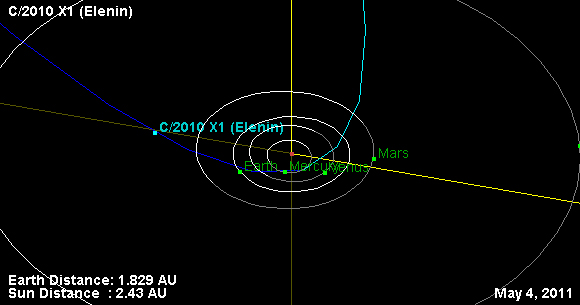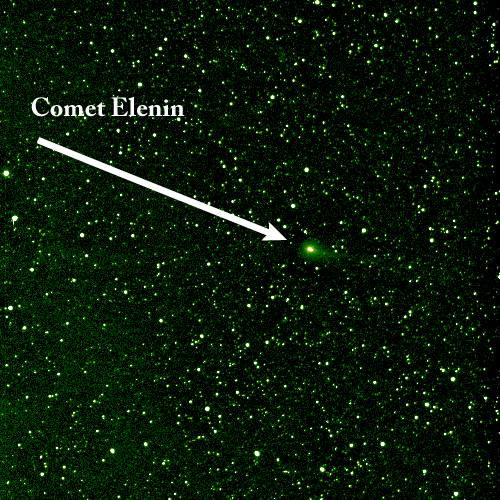Comet Elenin: Biggest Questions (and Answers) From NASA

Since the discovery of comet Elenin in December 2010, the faint,icy object has sparked a frenzy of speculation about its approach to the inner solar system over the next few months. That speculation has prompted many to send questions to NASA.
On Tuesday (Aug. 16), NASA released a list of the most popular questions (and answers) from the public over the arrival of comet Elenin in the inner solar system. The comet will fly closest to Earth in October, but poses no threat to Earth, the space agency said.
This full NASA-provided Q & A reviews the most-asked questions about comet Elenin received by NASA. The questions were submitted over several months and are answered by astronomer Don Yeomans of NASA's Near-Earth Object Program Office at NASA's Jet Propulsion Laboratory in Pasadena, Calif., and David Morrison of the NASA Astrobiology Institute at the NASA Ames Research Center in Moffett Field, Calif.
I've heard about three days of darkness because of Comet Elenin. Will Elenin block out the sun for three days?
"As seen from the Earth, comet Elenin will not cross the sun's face," says Yeomans.
But even if it could cross the sun, which it can't, astrobiologist David Morrison notes that comet Elenin is about 2-3 miles (3-5 kilometers) wide, while the sun is roughly 865,000 miles (1,392,082 kilometers) across. How could such a small object block the sun, which is such a large object?
Let's think about an eclipse of the sun, which happens when the moon appears between the Earth and the sun. The moon is about 2,500 miles (4,000 kilometers) in diameter, and has the same apparent size as the sun when it is about 250,000 miles (400,000 kilometers) away -- roughly 100 times its own diameter.
For a comet with a diameter of about 2-3 miles (3-5 kilometers) to cover the sun it would have to be within 250 miles (400 kilometers), roughly the orbital altitude of the International Space Station. However, as stated above, this comet will come no closer to Earth than 22 million miles.
I've heard there is a "brown dwarf" theory about Comet Elenin. Would its mass be enough to pull Comet Honda's trajectory a significant amount? Could this be used to determine the mass of Elenin?
Morrison says that there is no 'brown dwarf theory' of this comet. "A comet is nothing like a brown dwarf. You are correct that the way astronomers measure the mass of one object is by its gravitational effect on another, but comets are far too small to have a measureable influence on anything."
If we had a black or brown dwarf in our outer solar system, I guess no one could see it, right?
"No, that's not correct," says Morrison. "If we had a brown dwarf star in the outer solar system, we could see it, detect its infrared energy and measure its perturbing effect on other objects. There is no brown dwarf in the solar system, otherwise we would have detected it. And there is no such thing as a black dwarf."
Will Comet Elenin be visible to the naked eye when it's closer to us? I missed Hale-Bopp's passing, so I want to know if we'll actually be able to see something in the sky when Elenin passes.
We don't know yet if Comet Elenin will be visible to the naked eye. Morrison says, "At the rate it is going, seeing the comet at its best in early October will require binoculars and a very dark sky. Unfortunately, Elenin is no substitute for seeing comet Hale-Bopp, which was the brightest comet of the past several decades."
"This comet may not put on a great show. Just as certainly, it will not cause any disruptions here on Earth. But, there is a cause to marvel," said Yeomans. "This intrepid little traveler will offer astronomers a chance to study a relatively young comet that came here from well beyond our solar system's planetary region. After a short while, it will be headed back out again, and we will not see or hear from Elenin for thousands of years. That's pretty cool."
This comet has been called 'wimpy' by NASA scientists. Why?
"We're talking about how a comet looks as it safely flies past us," said Yeomans of NASA's Near-Earth Object Program Office. "Some cometary visitors arriving from beyond the planetary region – like Hale-Bopp in 1997 -- have really lit up the night sky where you can see them easily with the naked eye as they safely transit the inner-solar system. But Elenin is trending toward the other end of the spectrum. You'll probably need a good pair of binoculars, clear skies and a dark, secluded location to see it even on its brightest night."
Why aren't you talking more about Comet Elenin? If these things are small and nothing to worry about, why has there been no public info on Comet Elenin?
Comet Elenin hasn't received much press precisely because it is small and faint. Several new comets are discovered each year, and you don't normally hear about them either. The truth is that Elenin has received much more attention than it deserves due to a variety of Internet postings that are untrue. The information NASA has on Elenin is readily available on the Internet. If this comet were any danger to anyone, you would certainly know about it. For more information, visit NASA's AsteroidWatch site here.
I've heard NASA has observed Elenin many times more than other comets. Is this true, and is NASA playing this comet down?
NASA regularly detects, tracks and characterizes asteroids and comets passing relatively close to Earth using both ground- and space-based telescopes. The Near-Earth Object Observations Program, commonly called "Spaceguard," discovers these objects, characterizes a subset of them and predicts their paths to determine if any could be potentially hazardous to our planet. For more information, visit the NASA-JPL Near Earth objects site a:t http://neo.jpl.nasa.gov/.
However, neither NASA nor JPL is in the business of actively observing Elenin or any other comet. Most of the posted observations are made by amateur astronomers around the world. Since Elenin has had so much publicity, it naturally has attracted more observers.
I was looking at the orbital diagram of Comet Elenin on the JPL website, and I was wondering why the orbit shows some angles when zooming? If you pick any other comet, you can see that there are no angles or bends.
Many people are trying to plot the orbit of the comet with the routine on the JPL website, without realizing that this is just a simple visualization tool. While the tool has been recently improved to show smoother trajectories near the sun, it is not a scientific program to generate an accurate orbit. Yeomans explains that the orbit plotter on the Near-Earth Object website is not meant to accurately depict the true motion of objects over long time intervals, nor is it accurate during close planetary encounters. For more accurate long-term plotting, Yeomans suggests using the JPL Horizons system here.
Follow SPACE.com for the latest in space science and exploration news on Twitter @Spacedotcomand on Facebook.
Breaking space news, the latest updates on rocket launches, skywatching events and more!

Space.com is the premier source of space exploration, innovation and astronomy news, chronicling (and celebrating) humanity's ongoing expansion across the final frontier. Originally founded in 1999, Space.com is, and always has been, the passion of writers and editors who are space fans and also trained journalists. Our current news team consists of Editor-in-Chief Tariq Malik; Editor Hanneke Weitering, Senior Space Writer Mike Wall; Senior Writer Meghan Bartels; Senior Writer Chelsea Gohd, Senior Writer Tereza Pultarova and Staff Writer Alexander Cox, focusing on e-commerce. Senior Producer Steve Spaleta oversees our space videos, with Diana Whitcroft as our Social Media Editor.

